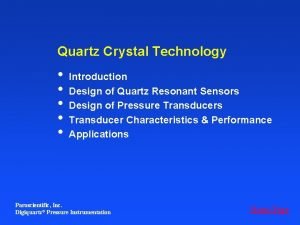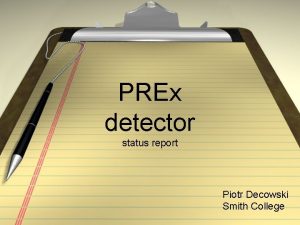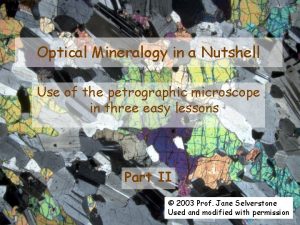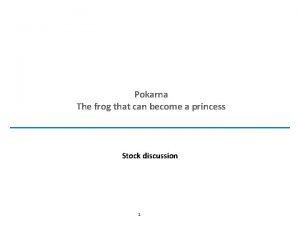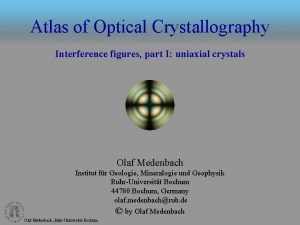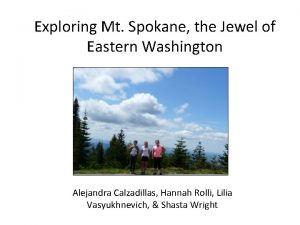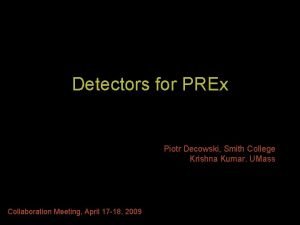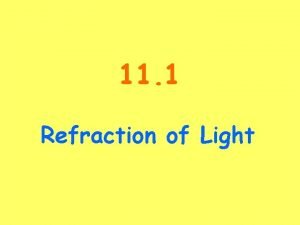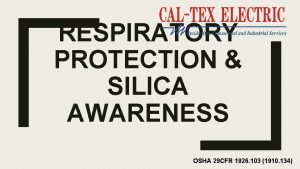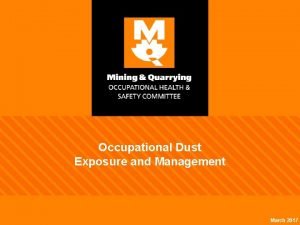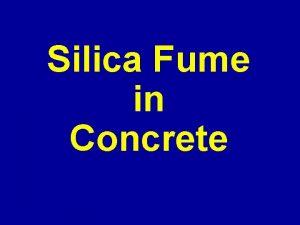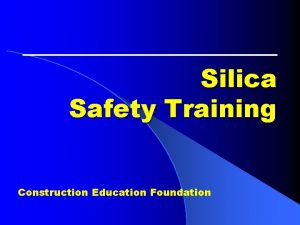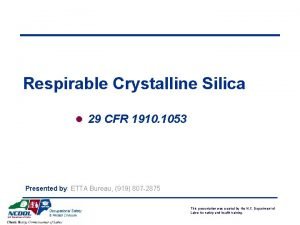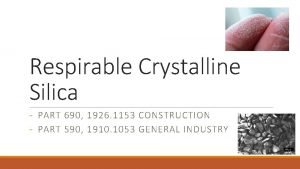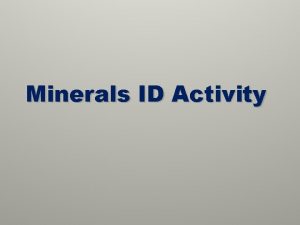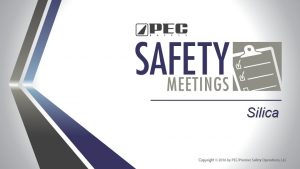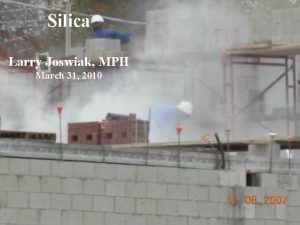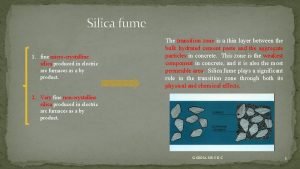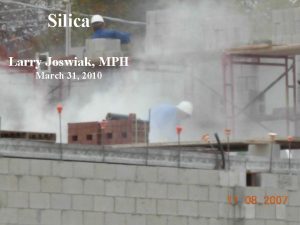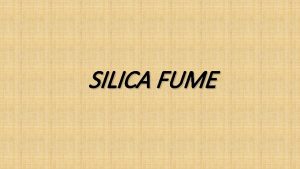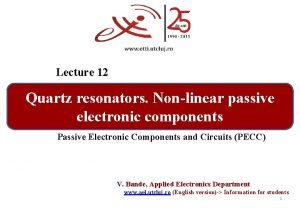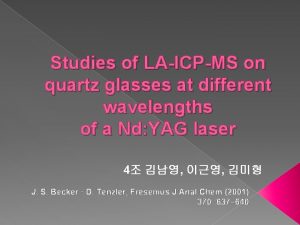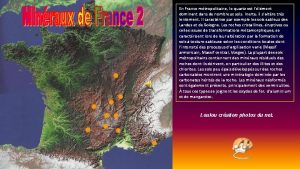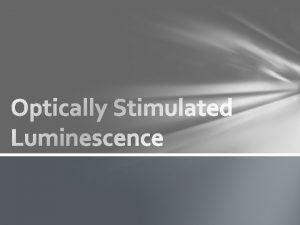Silica WHAT IS SILICA l SILICA IS QUARTZ





















- Slides: 21


Silica

WHAT IS SILICA? l SILICA IS QUARTZ ¡Quartz (silica) is found naturally in almost all rock, sand soil. ¡Silica is a principal component of sand ¡It is found in all concrete products

SILICA EXPOSURE IN INDUSTRY l Sandblasting l Foundry work l Concrete mixing l Concrete products l Manufacturing l Glass manufacturing l Work with abrasives

SILICA EXPOSURE Generates moderate to heavy amounts of dust Generates heavy amounts of dust

SILICA EXPOSURE (cont) DRILLING CONCRETE CUTTING

SILICA EXPOSURE (cont)

SILICA EXPOSURE (cont) SWEEPING AND BLOWING WITH AIR

SILICA EXPOSURE (cont)

WHAT IS SILICOSIS? l Silicosis is one type of pneumoconiosis ¡the medical term for lung scarring from inhaled dust. ¡Pneumoconiosis can occur from inhaled asbestos, coal, beryllium, and other inhalable dusts. l There is no effective treatment for any pneumoconiosis, including silicosis

THREE ‘TYPES’ OF SILICOSIS l Simple chronic silicosis ¡From long-term exposure (10 -20 years) to low amounts of silica dust. l Accelerated silicosis ¡Occurs after exposure to larger amounts of silica over a shorter period of time (5 -10 years). l Acute silicosis ¡From short-term exposure to very large amounts of silica dust.

SILICOSIS – ASSOCIATED RISKS l Increased risk of tuberculosis & lung cancer. l Degree of increased risk ¡is highly variable ¡depends on several OTHER factors, including limmune system lexposure history (for TB), lamount of lung scarring lage lsmoking history (for cancer).

SILICA EXPOSURE LIMITS The safest amount of silica in the air is zero. This is the legal limit set The legal limit is called a “permissible exposure limit” or “PEL”. This limit is for respirable (fine) dust. In the air – 100 micrograms per cubic meter Rule-of–thumb: if dust containing silica is visible in the air, it’s almost certainly over the permissible limit.

SILICA EXPOSURE CONTROL l Silica dust exposure can be controlled by use of water or exhaust ventilation to reduce dust l Capture or dispose of controlled dust l Avoid dry sweeping and use of compressed air on concrete l Respirators must be used if silica dust can’t be controlled with water or ventilation

SILICA EXPOSURE CONTROL l HEPA vacuum cleaners can be used instead of sweeping and air blowing. l Floors can be spray wet is sweeping is done. l Exhaust systems must be inspected and maintained l Areas with heavy traffic should be paved l Speed limits shall be posted

SILICA AND USE OF RESPIRATORS l When respirators are used, the employer must establish a respiratory protection program ¡outlined in the NIOSH Guide to Industrial Respiratory Protection [NIOSH 1987 a] ¡required in the OSHA respiratory protection standard [29 CFR 1910. 134 and 1926. 103].

SILICA AND USE OF RESPIRATORS l periodic environmental monitoring, l regular training of personnel, l selection of proper NIOSH-approved respirators, l an evaluation of the worker's ability to perform the work while wearing a respirator, l respirator fit testing, and l maintenance, inspection, cleaning, and storage of respiratory protection equipment.

SILICA AND USE OF RESPIRATORS l One-piece dust masks can also be used, but are not recommended because they don’t always fit properly and can leak. l Respirators may still be needed even when steps have been taken to reduce the amount of dust in the air. l A supplied air respirator is required if the amount of silica in the air is more than 10 times the permissible limit”

SILICA AND RESPIRATOR USE Employees using respirators must be trained Training is required for anyone who wears a respirator. If you don’t know how to use a respirator properly, you may think your respirator is providing protection when it is not.

SILICA AND RESPIRATOR USE l Respirators must fit properly to prevent leaks around the edges. l Fit-testing must be done before first wearing a respirator. l Beards are not allowed when wearing a respirator

SUMMARY l Remember silicosis can kill over time l There is no cure for silicosis l Keep dust down to a minimum l Use engineering methods or process controls l Last recourse use respirators
 Shocked quartz
Shocked quartz Quartz solutions inc
Quartz solutions inc Quartz crystal technology
Quartz crystal technology Quartz
Quartz Quartz smith college
Quartz smith college Quartz well
Quartz well Uniaxial and biaxial minerals
Uniaxial and biaxial minerals Quartz microbalance
Quartz microbalance Pokarna valuepickr
Pokarna valuepickr Interference figure
Interference figure Quartz mountain lookout
Quartz mountain lookout Quartz smith college
Quartz smith college Index of refraction formula
Index of refraction formula Colloidal silica gun mix
Colloidal silica gun mix 1926 silica
1926 silica Silica dust exposure
Silica dust exposure Silica fume slurry
Silica fume slurry Silica solubility
Silica solubility Silica beaver dam
Silica beaver dam Silica in foundation
Silica in foundation Osha silica standard 1910
Osha silica standard 1910 1926 silica
1926 silica


